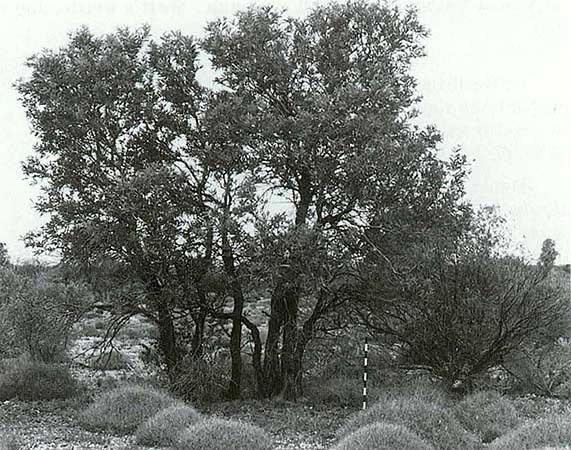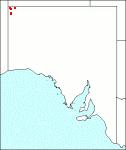Family: Fabaceae
Acacia pruinocarpa

Citation:
M.D. Tindale, Contrib.N.S.W. Herb. 4:73 (1968).
Derivation: pruina (L.)—waxy; karpos (Gr.)—a fruit.
Synonymy: Acacia notabilis Common name: gidgee
Description:
Shrubs or trees to 10 m high, multi-stemmed or single trunks for about 1 m or more before branching into a few main stems and forming quite dense spreading canopies; branchlets smooth somewhat pruinose, angular and soon becoming terete; bark dark grey, striated and fibrous.
Phyllodes linear, oblong or cultrate, 7-17 cm long, 6-30 mm broad, slightly oblique, straight or falcate, flat, thick, coriaceous, rigid, glaucous, mid-vein prominent with fine reticulate lateral veins, margins thickened and vein-like, apex obtuse; glands basal,
Inflorescences in false racemes with peduncles singly or in pairs, sparsely placed along the long axillary glabrous stalk; flower-heads globular, bright yellow, 55-65-flowered; peduncles 1-3.8 cm long, glabrous; flowers 5-merous.
Legumes stipitate, oblong, 3-10cm long, 9-17 mm broad, flat, but raised over the seeds, coriaceous, pruinose or reddish-brown; margins not constricted between seeds. Seeds transverse or obliquely placed in legume, almost orbicular, blackish; funicle short, filiform, thickening into a small cap-shaped aril.
|
|
Distribution:
|
Only a minor occurrence in the North-Western region in and near the Tomkinson and Mann Range area. In tall shrubland on sandy or rocky plains, associated with Acacia aneura and Triodia basedowii. Soils; neutral red earths. Rainfall approx 200 min. Also W.Aust. and N.T.
S.Aust.: NW.
|
Flowering time: October — December.
|

SA Distribution Map based
on current data relating to
specimens held in the
State Herbarium of South Australia
|
Biology:
No text
Related taxa:
Acacia notabilis (sp. 53) has some similarity in the appearance of the phyllodes but differs markedly in its flower structure, more numerous heads per raceme and shorter, stouter peduncles.
Cultivation:
Little known; recommended as a small shade tree for dry inland areas.
Author:
Not yet available
Source:

|

